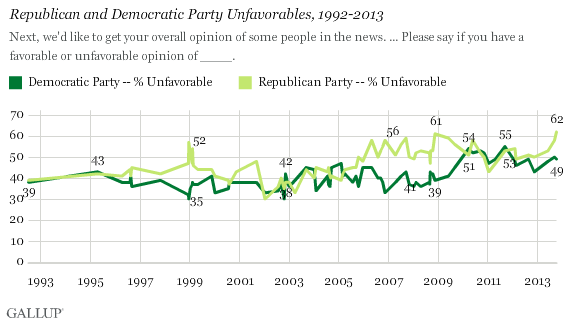This article is part of an ongoing series analyzing how the government shutdown and the debate over raising the debt ceiling are affecting Americans' views of government, government leaders, political parties, the economy, and the country in general.
WASHINGTON, D.C. -- With the Republican-controlled House of Representatives engaged in a tense, government-shuttering budgetary standoff against a Democratic president and Senate, the Republican Party is now viewed favorably by 28% of Americans, down from 38% in September. This is the lowest favorable rating measured for either party since Gallup began asking this question in 1992.

The Democratic Party also has a public image problem -- although not on the same elephantine scale as that of the Republican Party -- with 43% viewing the Democratic Party favorably, down four percentage points from last month.
These findings come from a Gallup poll conducted Oct. 3-6 that followed the Oct. 1 partial government shutdown after lawmakers in Washington were unable to pass a spending plan for the federal government.
More than six in 10 Americans (62%) now view the GOP unfavorably, a record high. By comparison, nearly half of Americans (49%) view the Democratic Party unfavorably. Roughly one in four Americans see both parties unfavorably.

Republicans More Likely to See Own Party Unfavorably
Self-identified Republicans are more than twice as likely to view their own party unfavorably (27%) as Democrats are to see their own party unfavorably (13%). The GOP's unfavorable rating among Republicans is up eight points from September, compared with a one-point rise in Democratic Party unfavorables among Democrats. These findings may be consistent with the widely circulated narrative that the Republican Party is internally splintered on how best to handle the budgetary negotiations.
Independents, meanwhile, remain unimpressed with both parties: Thirty-two percent view the Democratic Party favorably, while 27% view the Republican Party favorably.
Implications
As the two major political parties are locked in a high-stakes political imbroglio that has resulted in a government shutdown and may cause the first-ever default on the national debt, Americans are more likely to view both parties negatively than positively. The Republican Party is clearly taking a bigger political hit from Americans thus far in the unfolding saga, with 28% rating the GOP favorably -- a loss of 10 points from only a month ago. This contrasts with previous Gallup findings from just before the government shutdown showing the Republican Party making up ground on a few key issues. Thus, the Republican Party's current strategy in the fiscal debates may not be paying dividends.
For their part, the Democratic Party has also seen its favorability rating drop since September, though by a smaller four points. Moreover, both parties are down from where they were just after the 2012 elections, indicating the many political battles of 2013 have had a corrosive effect on the two parties' images.
Survey Methods
Results for this Gallup poll are based on telephone interviews conducted Oct. 3-6, 2013, on the Gallup Daily tracking survey, with a random sample of 1,028 adults, aged 18 and older, living in all 50 U.S. states and the District of Columbia.
For results based on the total sample of national adults, one can say with 95% confidence that the margin of sampling error is ±4 percentage points.
Interviews are conducted with respondents on landline telephones and cellular phones, with interviews conducted in Spanish for respondents who are primarily Spanish-speaking. Each sample of national adults includes a minimum quota of 50% cellphone respondents and 50% landline respondents, with additional minimum quotas by region. Landline and cell telephone numbers are selected using random-digit-dial methods. Landline respondents are chosen at random within each household on the basis of which member had the most recent birthday.
Samples are weighted to correct for unequal selection probability, nonresponse, and double coverage of landline and cell users in the two sampling frames. They are also weighted to match the national demographics of gender, age, race, Hispanic ethnicity, education, region, population density, and phone status (cellphone only/landline only/both, and cellphone mostly). Demographic weighting targets are based on the March 2012 Current Population Survey figures for the aged 18 and older U.S. population. Phone status targets are based on the July-December 2011 National Health Interview Survey. Population density targets are based on the 2010 census. All reported margins of sampling error include the computed design effects for weighting.
In addition to sampling error, question wording and practical difficulties in conducting surveys can introduce error or bias into the findings of public opinion polls.
View methodology, full question results, and trend data.
For more details on Gallup's polling methodology, visit www.gallup.com.
